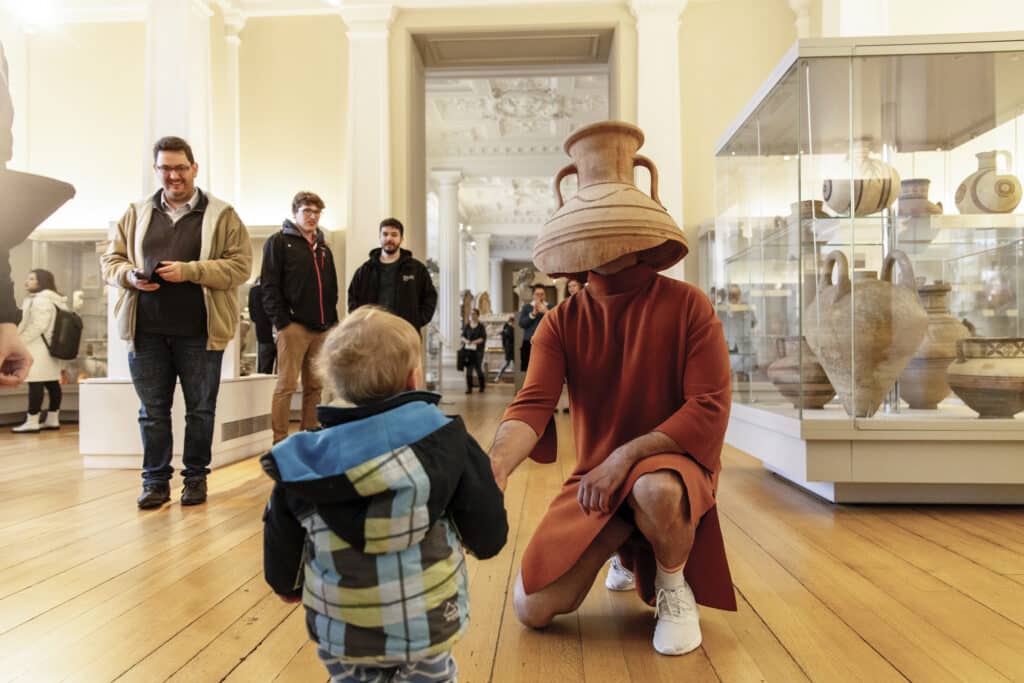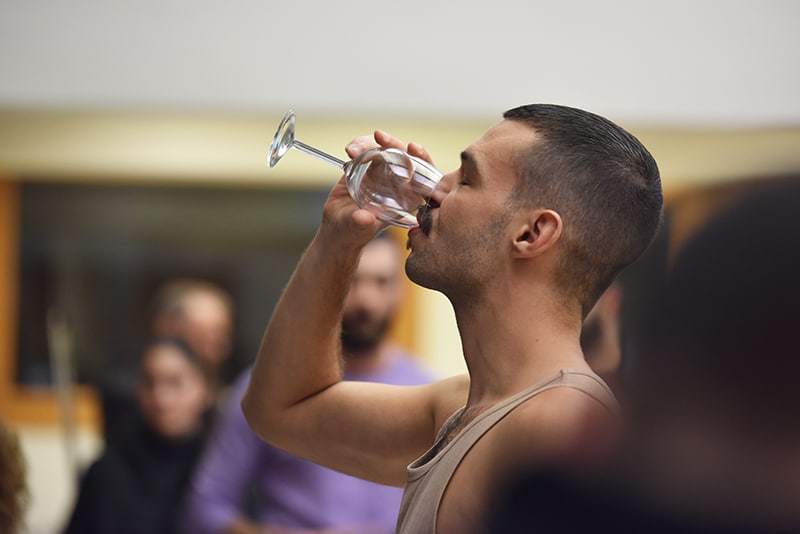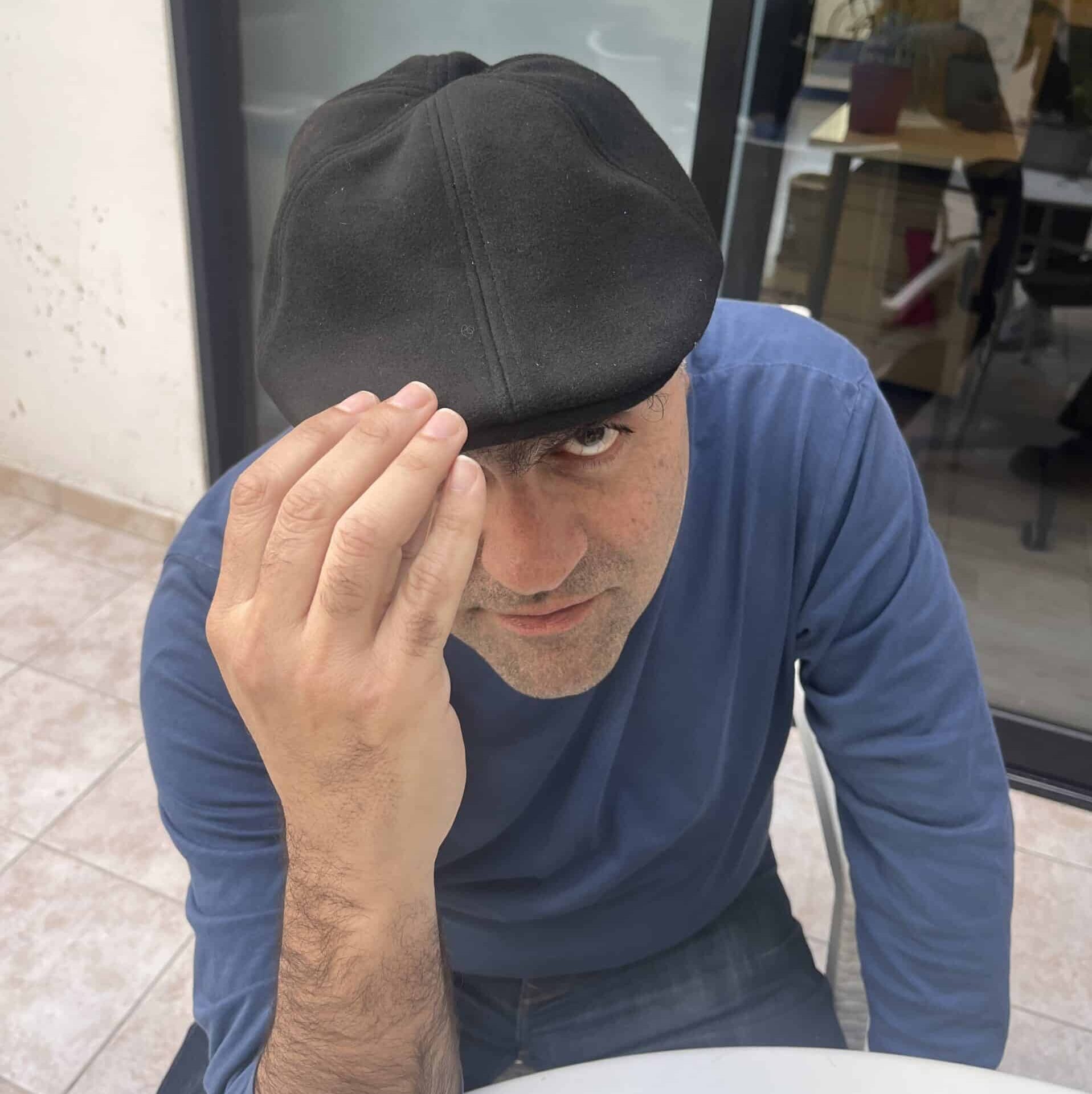Using the body itself as art, one local man with a curated look is both playful and serious. THEO PANAYIDES meets a man (once half fish) who trusts his instincts
He’s been a merman (half-man, half-fish), a column – actually a caryatid, one of the statues supporting the Parthenon – and a kind of human palm-tree, among other things. But mostly he’s PASHIAS, not just Pashias (though that is his real surname) but the all-caps version and indeed the English version, even in a Greek context – a performance artist whose art is based around “establishing the artist’s body as primary material for creation,” according to the blurb on his YouTube channel.
PASHIAS is a brand, of course, a persona. (His first name isn’t some dark secret – it’s right there on his Facebook page – but will not be divulged in this profile.) He even looks a bit like a brand – that’s to say, artificial – with his close-cropped hair and trim-but-chunky moustache, a curated look in an age of general sloppiness. His English is fluent but prone to verbosity, the language (I suspect) he associates more with art school, and talking about his oeuvre – he studied Fine Art & History of Art at Goldsmiths in London, followed by a Master’s at Central Saint Martins – than everyday conversation.

That performance, by the way – entitled ‘Ω3’ (i.e. fish oil) with a typical flourish of dry humour – was a so-called ‘public intervention’, meaning it didn’t take place in an art gallery but right out in public, in Eleftheria Square in the heart of the capital. “A living creature is carried by two men and placed at the Square’s centre, at a distance from its natural element – water,” begins the description of the action on his website (pashias.art). Crawling around on his (its?) elbows, the merman negotiated a “controversial oval bench designed by architect Zaha Hadid”, climbed up, fell off, crawled around and ended up – in Part III of the one-hour performance, ‘Catharsis’ – in a water fountain, finding “emotional release” before being literally carried away. It was pretty intense.
Why do it, though? What, one might say, is the point? His work seems especially vulnerable to that sort of narrow criticism, requiring no obvious ‘talent’ beyond just a willingness to perform the action. “‘What does it mean?’ or ‘My kid could do that’ comes as a response to all forms of expression, not just performance art,” he agrees. “But it can more easily pop up in regards to live performance.”
What if someone doesn’t get one of his pieces, though?
“That’s perfectly fine. There is nothing to ‘get’,” he replies, and laughs. “Artists are not geniuses, we don’t carry an answer to, like, a mystical, universal truth. We can only carry questions, or alternative ways of understanding and interpreting our current reality.”
‘Ω3’ is a case in point. The press release (there’s always a press release) talked of diversity and social acceptance – but “I have no connection in mind,” insists PASHIAS, it’s up to the audience. If someone saw the fish-man and thought about the oceans being overfished, that’s fine. If someone else thought of access for disabled visitors (“since this fish is crawling, not using its feet”), also fine. If some eight-year-old kid just fell about laughing at the sight of a fish in a public square, even better. (“I trust children the most.”) But it’s also true that the performance took place on Pride Day – one of the media articles on his site calls it “a ‘queer’ perspective questioning the body and its conventions” – and prompted a backlash in some quarters which (he says) came close to hate speech.

Pashias taking part in one of his events
Pashias the man (as opposed to PASHIAS the brand) is presumably also part of the LGBT community – but we don’t delve very far behind the persona, or perhaps the persona is just more interesting. He’s 35, in a relationship, something of a foodie (his restaurant of choice is Tocayo), sociable but “a bit agoraphobic”. How light or heavy is his temperament? Is he dark, as a person? – but the question is smoothly evaded: “I am everything! I am extremely dark, extremely light, extremely serious, extremely funny… I do nothing on purpose.”
Well, what comes naturally to him?
“Instinct. We all have instinct. We all have inner voices – it’s a matter of who listens to them, how do you interpret your instinct.” PASHIAS nods sagely: “I trust myself. For this part, I trust myself. I trust me listening to my instincts”.
And he always has?
“Yes. 100 per cent.”
That’s important, especially doing what he does – to have the confidence that comes from being in touch with one’s creativity from an early age. He was always able to be “creatively chaotic”, even as a child, and was lucky enough to be born into an artistic family (his mum, who passed away last year, was a fashion designer) who spotted and encouraged his potential; “I went to art classes from the second grade of primary school”.
He works on instinct because his willingness to listen to his inner voice – his penchant for creative chaos – is his most basic tool as an artist; he doesn’t have a script, or a musical score, or a paintbrush. It all comes down to having faith in his vision – especially because, as he puts it, “my ideas sound stupid on paper. They do. I know it”. Performance art is partly the art of curating experiences, the gift of being able to see that a certain action, placed in a certain context at a certain time (his art is ephemeral; “What I do, I only do it once”) can create a stir, a frisson that may not be apparent if you just described the action on paper.
Thus, for instance, ‘Temple-boy’ from 2017, another of his Cyprus-based pieces (he’s also performed as far afield as Brazil and Canada). “The audience gathers at the entrance of the museum, being offered a glass of red wine by the museum’s staff,” explains the description. They assume it’s a refreshment (an “offering”), like you frequently get at art openings. The artist then performs a piece of business with a bunch of grapes, eating each grape and ‘excreting’ it in the form of a clear plastic marble, which he reveals behind his back.
“He then slowly approaches the first audience member and takes the glass of wine from their hand,” says the description. “I went to each member of the audience,” confirms the man himself, picking up the story, “looked them straight in the eye, got their glass while looking at them, and finished all of the audience member’s wine. And that was the condition I set myself: ‘I will not stop until I drink all of the wine’. It was the idea of altering, or stopping this offering, and interrupting the viewership of the piece.”

Pashias drinking wine as part of the event
A few things come to mind here. First, reading that description surely can’t compare with the shock of the actual experience – an audience member sipping their glass of wine, watching the performance and feeling like a good culture vulture, only to have the artist suddenly turn on them, grabbing the glass from their hand (PASHIAS’ pieces are performed only once; no-one could’ve known what was going to happen). Second, this is not an idea you could easily sell to a corporate sponsor (though in fact it was backed by the Bank of Cyprus Cultural Foundation, part of an event called ‘Moments at the Museum’). Third, and most importantly… that’s a lot of wine to gulp down all at once and keep performing.
It’s true, says PASHIAS: in life he’s not a big drinker, getting tipsy after just a couple – yet he finished that performance with no ill effects. He mentions another example, ‘Periphora’ from 2019, “where I was turning around clockwise at the same pace for two consecutive hours”; he tried it in rehearsal and was sick after 15 minutes, yet was fine on the night. It’s like he becomes “the superhuman version of PASHIAS” when performing, he explains with a chuckle: “I’m sure of myself, I am 100 per cent present… and I do not overthink. I am much more efficient as a human being during my performances”.
He’s done a lot, challenging himself in various ways; ideas are always churning away, “a plethora of images in my head”. ‘Diagrama’ from 2016, in Athens in collaboration with the Marina Abramovic Institute, when he performed for 18 consecutive hours. ‘Metaphora’, a one-hour piece where PASHIAS simply stands on a plinth so his head is touching the ceiling, seemingly holding up the room while his viewers “initiate a process of social engagement” among themselves. ‘Dame’ from 2021, the aforementioned palm-tree piece, buried (or rooted) in the ground up to his calves. ‘I got the power’, where he arm-wrestled members of the audience while pumping air into a balloon placed over his right bicep, giving him cartoonishly huge muscles. ‘KUZA’, his most recent piece – performed in February at the Fitzwilliam Museum in Cambridge, a trove of Cypriot antiquities – with the artist transforming himself via a broken amphora placed over his head.
Why does he do it? Because he wants to. Because he’s an artist. Because the unmediated nature of the images in his head being consummated through his actual body as a performer thrills him more than, for instance, being an actor (an early ambition) could ever do. What about in everyday life, though, when he’s not the superhuman version of PASHIAS? Is it easy being so unconventional? – especially in Cyprus where, let’s face it, “a sense of comfort” (his words) tends to trump a sense of adventure, artistic or otherwise.
“It’s not a matter of conventional or unconventional,” he replies, unfazed. “Nothing I do is bizarre to me. It’s what other people do that is bizarre.
“Why are you passing with a red light, and why are you driving at 150 miles an hour? Why are you yelling at someone who’s holding someone else’s hand, and living their love?… I mean, these ‘performative’ acts – in quotation marks – are more bizarre than my acts.” And that’s not even mentioning all the other performance art that’s revered in our culture: the rituals and ceremonies, Christmas and Easter, the collective reimagining of bread and wine as body and blood.
PASHIAS himself is spiritual in a very particular way – the way you’d probably expect from someone whose art is so explicitly an extension of himself, whose inner voice is so bold and confident, whose mind has been teeming since childhood with outlandish ideas. He feels no need of religion to tell him what to do (nor does he believe in an afterlife) – but “I am a spiritual type of the present,” he tells me. “Of now. We are here, now. It’s me and you, sitting at this table, looking at each other. This is spiritual… I believe in human energy.”
His own energy is brash and unaffected – though also veiled behind a brand, and often dispersed in doing non-artistic (but necessary) things. “When I was young I said that I was three-quarters a secretary, one-quarter artist. And it’s still true to this day,” he sighs. “The amount of bureaucracy that comes with creation is extremely intense”. He makes a living, without any need for a day job, but each new project is a new battle. Wouldn’t life be great if he could just follow his instincts, without all this endless haggling and form-filling?
Still, PASHIAS is PASHIAS (and Pashias is also PASHIAS; but that’s a different story) –an artist both playful and serious, personal and political. In the end, his art is based on interaction as much as self-expression – especially now, when it’s shifted from the gallery to the public square. It’s a question of bodies in proximity, he muses, the artist and the audience: “So it’s a parallel to society. It’s the one, and the others”. His own ‘others’ haunt our conversation – the merman, the caryatid, the amphora, the arm wrestler. And the lifelong artist with a talent for creative chaos? Him too.







Click here to change your cookie preferences